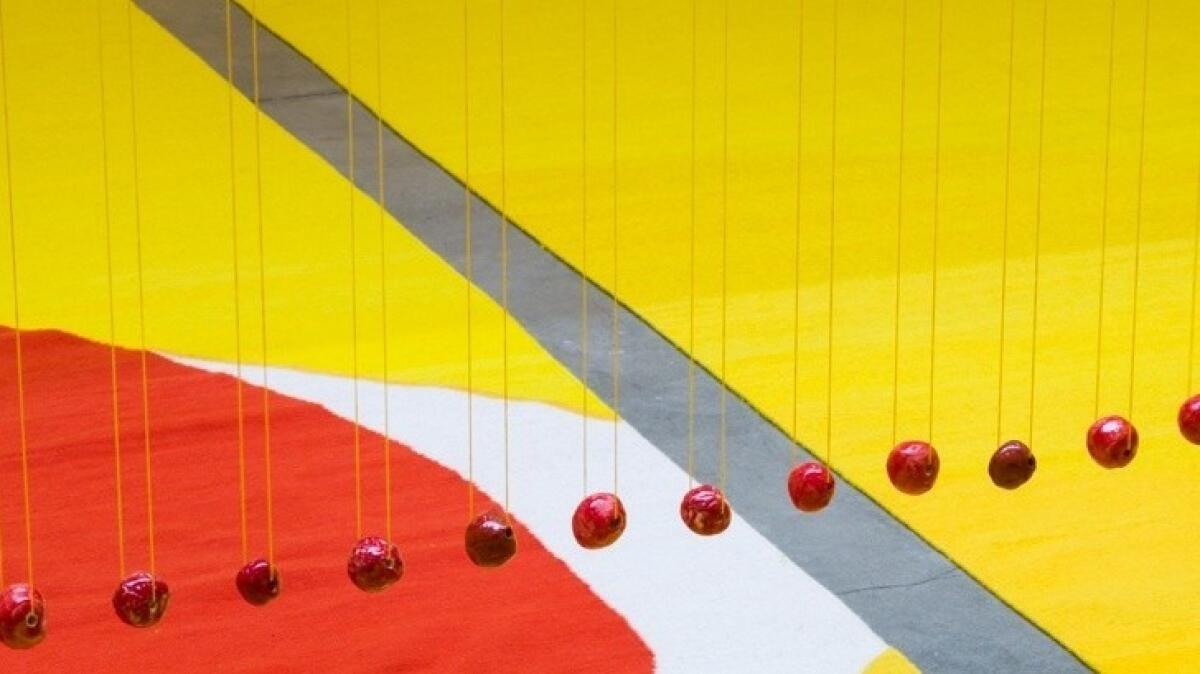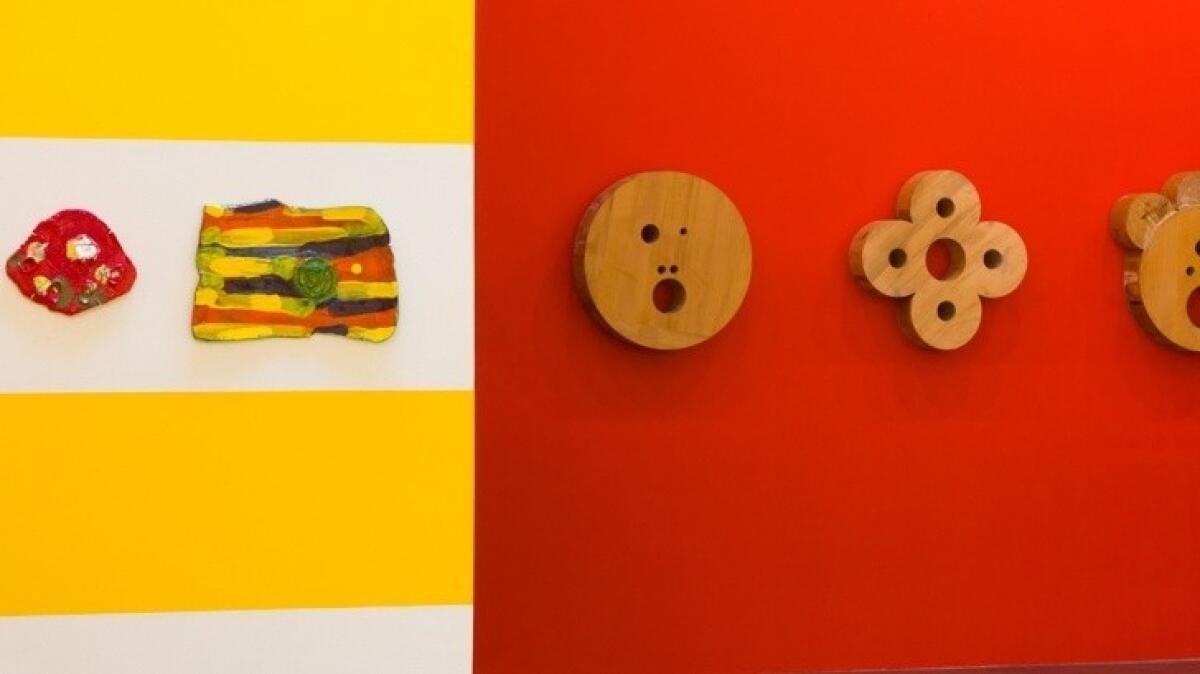Review: Polly Apfelbaum’s fallen paintings and beads of devotion in her secular chapel of abstract art
A secular chapel might seem an impossible contradiction in terms — an unsustainable union of worldliness and divinity. The mystery of mortality doesn’t merge easily with the empirical here-and-now.
Yet that is what is invoked by a large, lovely new installation by Polly Apfelbaum. The words “secular chapel” aren’t used in didactic material around the show, “Face (Geometry) (Naked) Eyes,” which fills the Ben Maltz Gallery at Otis College of Art and Design. The closest it comes is to identify the work’s inspiration: a famously eclectic floor mosaic in a “tree of life” pattern inside a 12th century church in Otranto, Italy.
That huge mosaic piles up dozens of seemingly contradictory symbols from Christian legend, Greek myth, Scandinavian folklore, Persian fable and more. Apfelbaum, who doesn’t show often in Los Angeles — her most recent solo exhibition here was at Hollywood’s Michael Benevento Gallery five years ago — does something similar, albeit in abstract form, with forms she’s employed for years.
Carpets and glazed ceramic plaques, both emphasizing color, as well as wooden wall reliefs are fashioned with a multicultural symbolism that favors abstraction. One could even say that colorful abstraction is her kachina — her ancestral spirit guide.
Take the four big, rectangular carpets in the center of the floor. Woven in Oaxaca, Mexico, according to Apfelbaum’s designs, each is a vivid yellow field interrupted by a pristine white lozenge, inside of which a bright red-orange circle nestles. At 13-by-25 feet apiece, the carpets dominate the space.
The design looks a bit like a hard-boiled egg. From another angle, it’s a schematic eye. Since ancient times, the all-seeing eye has signified esoteric spiritual power.
Simple geometric shapes in big swaths of pure, unmodulated color also make a witty nod to Modernist art history. Born in 1955, the New York-based Apfelbaum matured into an art world where Color Field painting (or Post-painterly abstraction, as the work of its successors is sometimes known) had lately been overthrown as “the next logical step” in high art’s supposed advance toward formal perfection. By the 1970s, Mark Rothko and Barnett Newman were revered, but they were in the past. Their spiritual quest through abstract avenues of color had fallen from grace.


In Apfelbaum’s carpets, Color Field has fallen to the floor. She even calls such works “fallen paintings.” Metaphorically, Eve’s trouble in the biblical garden hangs unavoidably in the air. But Color Field’s yearning for a mythic abstraction that could be a transcendent doorway to the infinite persists, woven into a functional rug by Mexican artisans’ hands.
Now, however, the prayer rug is secular. And its sources reach beyond the limited European canon of Modern art.
There are prayer beads, too. On long threads, Apfelbaum has suspended a double row of little handmade ceramic spheres. They hang from the central skylight. The 218 beads glisten in their crimson glaze, catching the light that cascades from the ceiling window above.
Buddhism, Catholicism, Sufism, Hinduism — in countless belief systems, religious beads keep track of the rhythmic repetitions of prayers, chants or devotions. They articulate the faith — which here might be seen in the scores of homemade ceramic tablets with which Apfelbaum rings the entire room.
Scored, gouged and adorned with colorful glazes, they embody one of art’s most ancient forms. Affixed to walls painted in wide stripes of yellow and white, these humble, abstract clay tablets embody a covenant with art.
Finally, a separate enclosed space at the rear of the gallery and painted a fiery, red-orange hue operates as a kind of chancel to the main room’s golden nave. Six abstract “heads,” wood reliefs the artist began to make in 1988, are lined up across the wall — icons of a generalized humanity watching over the art experience.
In Apfelbaum’s carpets, Color Field has fallen to the floor.... The prayer rug is secular. And its sources reach beyond the European canon of Modern art.
Apfelbaum’s chapel is not nondenominational. You are required to remove your shoes to enter, but neither religious piety nor explicit holy creeds are part of the mix. Instead the emphatically secular space merges resolute solemnity, high design and wit.
Inside this cheerful space for elevated contemplation, the stereotype of the artist mired in his own spiritual misery unravels. An enchanting place of eccentric celebration, Apfelbaum’s secular chapel threads the contradictory needle in surprising and pleasurable ways.
--------------------
Polly Apfelbaum: “Face (Geometry) (Naked) Eyes”
Where: Ben Maltz Gallery, Otis College of Art and Design, 9045 Lincoln Blvd., Los Angeles (310) 665-6905
When: Through Dec. 4; closed Mondays.
Info: www.otis.edu
See the most-read stories in Entertainment this hour »
Twitter: @KnightLAT
ALSO
MOCA's Gaetano Pesce exhibition stumbles across a bright ethical line
'The Gildless Age': A different tale of the '1 percent' at the Torrance Art Museum
Tacita Dean's remarkable hand-drawn cloud prints at Gemini G.E.L.
Valerie Jaudon's paintings: The more you look, the more you're pulled into her world
Abraham Cruzvillegas' deft view of L.A. car culture at Regen Projects
The biggest entertainment stories
Get our big stories about Hollywood, film, television, music, arts, culture and more right in your inbox as soon as they publish.
You may occasionally receive promotional content from the Los Angeles Times.








